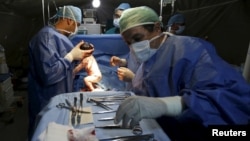The death rate among women undergoing a C-section to deliver a baby is about 50 times higher in Africa than in most wealthy nations, researchers said Friday.
One in 200 women dies during or soon after a cesarean in a sampling of nearly 3,700 births across 22 African countries, they reported in The Lancet Global Health.
By comparison, maternal mortality is about one woman per 10,000 operations in Britain. Death rates related to C-sections are roughly the same across most developed countries.
Urgent need to improve safety
“The findings highlight the urgent need for improved safety for the procedure,” said researchers led by Bruce Biccard, a professor at the University of Cape Town in South Africa.
Preventable C-section deaths mostly stemmed from a ruptured uterus, in mothers who had pre-existing placental complications, bleeding before birth or during surgery, and problems related to anesthesia.
“Improvement of C-section surgical outcomes could substantially improve both maternal and neonatal mortality,” Biccard said.
He also called for a better assessment of the risk related to bleeding, and less restrictive use of drugs to treat post-partum hemorrhaging.
In many African nations, there is a chronically short supply of blood for transfusions.
Blood products with a greater shelf life and better use of anesthesia by non-doctors — through mobile and online training, for example — could also help boost survival rates, the researchers said.
Surgical study
The findings are part of the Africa Surgical Outcomes Study, which tracks all patients who received surgery at 183 hospitals across the 22 countries for seven days.
C-sections accounted for a third of all surgeries in the period covered, the study found.
Making C-sections more easily available could also avoid potentially lethal complications, the authors noted.
Of the cases examined, 75 percent were classified as “emergency surgery,” with mothers arriving at the operating room with high-risk conditions.
“Paradoxically, while many countries are aiming to reduce cesarean delivery rates, increasing the rate remains a priority in Africa,” Biccard said.
C-section double worldwide
Worldwide, the number of C-sections has nearly doubled over the last 20 years, reaching unprecedented proportions in some countries, recent research has highlighted.
In Brazil, Egypt and Turkey, for example, more than half of all births are done via C-section.
But in close to a quarter of nations surveyed, many in Africa, use of the procedure is significantly lower than average.
It is estimated that the operation is medically necessary 10-15 percent of the time.
In 2015, doctors performed 29.7 million C-sections worldwide, 21 percent of all births.
This was up from 16 million in 2000, or 12 percent of all births.







